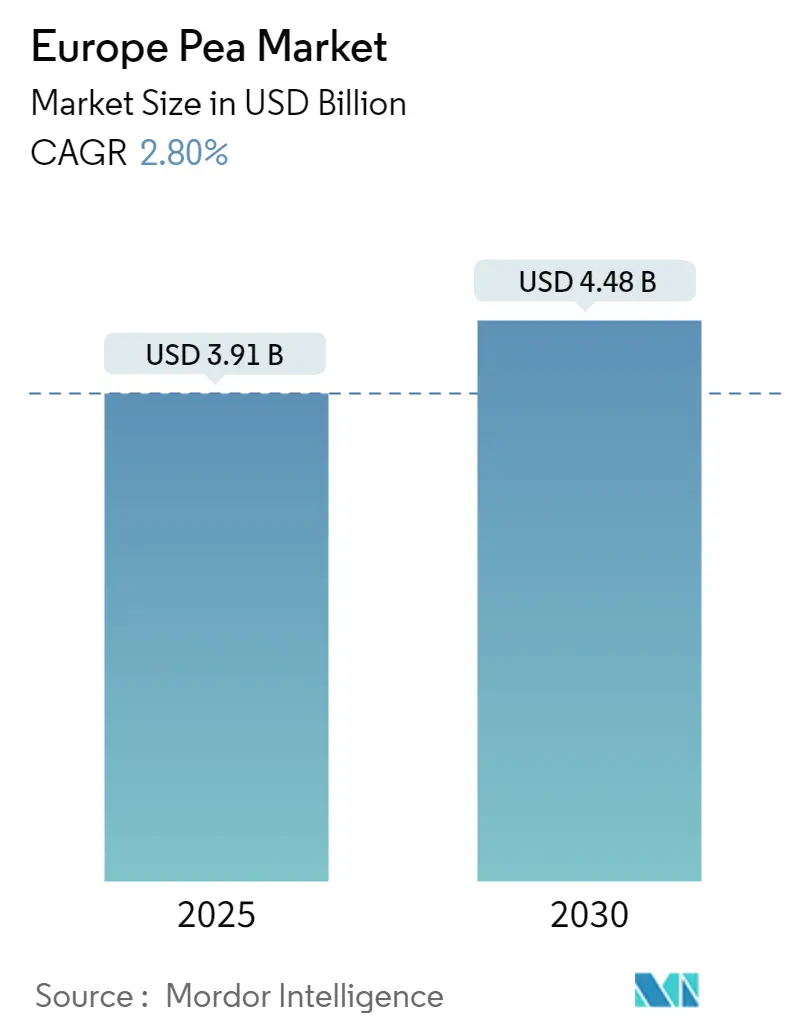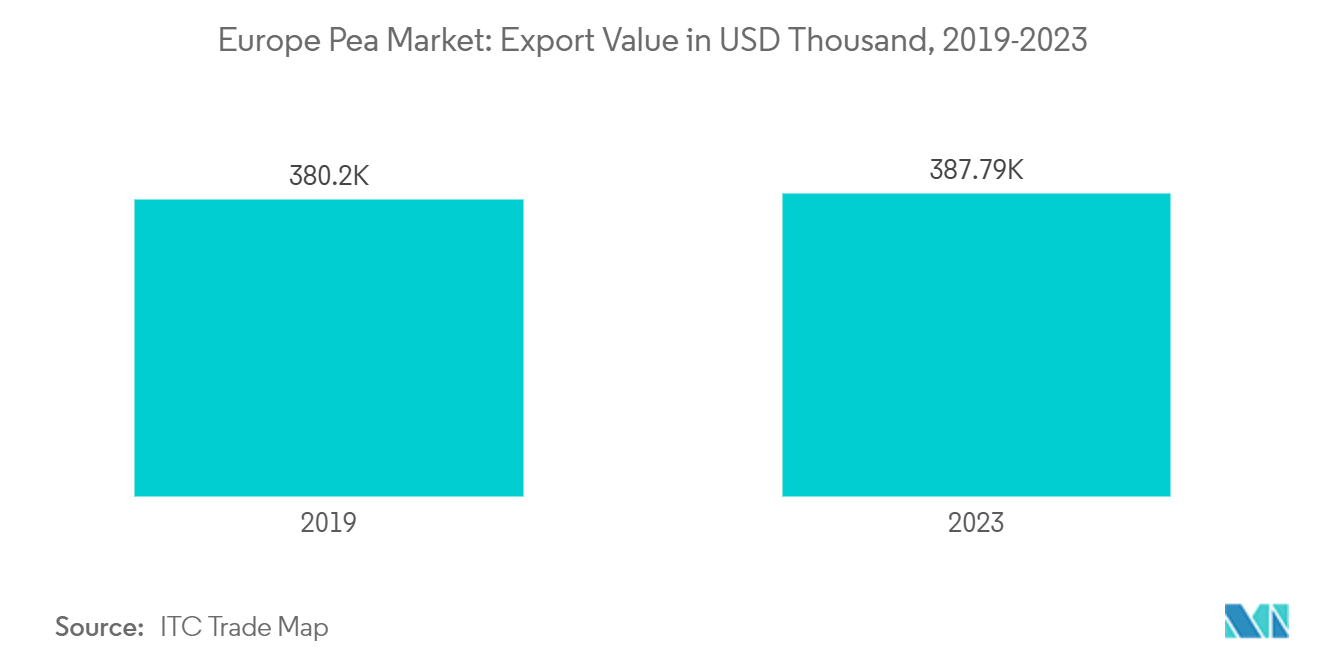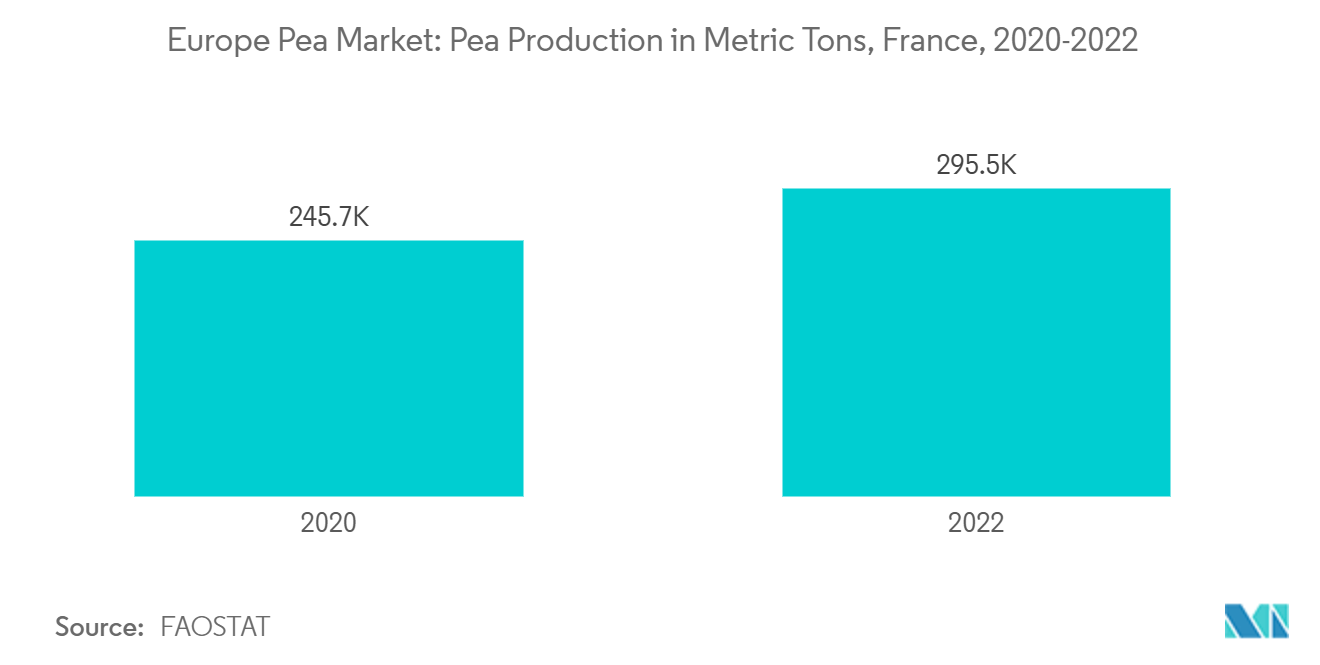Europe Pea Market Analysis
The Europe Pea Market size is estimated at USD 3.91 billion in 2025, and is expected to reach USD 4.48 billion by 2030, at a CAGR of 2.8% during the forecast period (2025-2030).
- Peas, cultivated for centuries across various European nations, boast high nutritional value and protein content. Rich in amino acids, proteins, and sugars, peas find their largest producer in France. Leading the continent, France excels in cultivating both garden and dried peas. For instance, according to FAOSTAT, the developed area for dry peas in France was 133,490 hectares; for fresh peas, the cultivated area was 44,540 hectares in 2022. While Germany, Spain, and Ukraine also produce significant quantities, France's dominance in pea production is evident, bolstered by the country's favorable growth climate. Additionally, southern Russia, particularly the Caucasus and Volga regions, has a long-standing history of pea cultivation.
- In Germany and other European nations, the consumption of peas has surged, driven by a rising demand for pea protein, a growing vegan and vegetarian population, and heightened health consciousness. Reports from the USDA's Foreign Agriculture Service in 2022 highlighted that Germany's vegan population surpassed 1.5 million, with over half the populace favoring plant-based over animal-based products. This trend underscores the untapped potential for vegan items like peas.
- Moreover, the import of fresh peas in European countries has been observed to increase in recent years. According to the ITC trade Map, in the year 2022, the total import volume of fresh peas was observed at 430,634 metric tons, which increased to 431,103 metric tons in the year 2023. Demand for these imports is shaped by culinary trends, cultural preferences, and the rising popularity of plant-based proteins. Given the growing consumer interest in vegan diets, the demand for imported peas as a protein-rich alternative is poised to rise in the future.
Europe Pea Market Trends
Europe's Expanding Pea Export Market
Pea proteins have gained popularity across Europe due to their high nutritional value and increased Western influence, enhancing export potential from the region. According to the ITC Trade Map Statistics Database, Europe's pea exports increased from USD 380,195 thousand in 2019 to USD 387,791 thousand in 2023. The Netherlands, France, Germany, and Belgium are significant pea exporters in the area, accounting for nearly 30% of total exports in 2023. France is one of the major exporters of green peas, with export shares of 90.6% to Belgium and 6.2% to the Netherlands in 2023.
Government initiatives to increase pea production acreage and subsequent growth in domestic production are anticipated to enhance export opportunities. For example, in 2021, the Netherlands Ministry of Agriculture, a leading exporter in Europe, initiated efforts to increase the area used for high-protein crop cultivation, including peas, by a factor of five. The Ministry's National Protein Strategy aims for Dutch farmers to utilize 100,000 hectares for growing protein-rich legumes within a decade, five times the current area in use.
Furthermore, the European food processing industry is expanding its use of peas in various products, including protein powders, soups, snacks, and animal feed. As food manufacturers seek sustainable, non-GMO, and gluten-free ingredients, the demand for imported peas is increasing, driving up exports from major producers.
France Dominate the Market in the Region
France leads Europe in pea production, thanks to its favorable climate and fertile lands. The country's varied farming regions excel in cultivating both dry and garden peas. Key production areas like Hauts-de-France, Brittany, and Centre-Val de Loire boast optimal soil conditions and temperate weather. French growers, responding to market demands, cultivate a diverse range of pea varieties, including Cortex, Iconic, Cosmos, Brelen, Persan, Shazam, KWS Kidam, Hexago, Helio, and Jumper. FAOSTAT data reveals that France produced 245,700 metric tons of fresh green peas in 2020, a figure that rose to 295,500 metric tons by 2022.
France's strong domestic demand, especially for processed foods, animal feed, and plant-based pea protein, fuels its pea production. Additionally, France exports a significant amount of peas, particularly for food processing and animal feed, to markets in Germany, Spain, the UK, Italy, and other European nations, highlighting the quality of its produce.
Besides, French agriculture benefits from strong government policies, subsidies, and incentives, particularly under the European Union’s Common Agricultural Policy (CAP). These policies support sustainable farming, crop rotation (with peas as an important rotation crop due to their nitrogen-fixing properties), and innovation in the agricultural sector, which has helped increase pea production.
Europe Pea Market News
- February 2023: Roquette, Agri Obtentions, Eurial, Greencell, INRAE, and the Université Lumière Lyon 2 have unveiled a joint initiative: AlinOVeg, titled “Innovating in Plant-Based Food.” Over the next five years, these public and private entities will collaborate to tackle challenges in the plant-based food sector. Their goals include cultivating a French sector centered on plant-based sources, specifically pea and fava bean proteins, and providing healthier, sustainable alternatives to dairy products. The initiative boasts a budget of €11.4 million, with €8.3 million sourced from the French government under the France 2030 initiative.
- September 2022: Lantmännen, an agricultural cooperative in Northern Europe, invested over SEK 1 billion (USD 95.7 million) in a new large-scale production facility for pea protein in Lidköping, Sweden, which is expected to be completed in early 2026.
- May 2022: China and Russia signed a phytosanitary protocol for peas opening the door for competition in Canada's top market. In the upcoming years, Russia will start exporting peas to China, increasing competition for Canadian exports.
Europe Pea Industry Segmentation
The pea is the tiny, spherical seed or seed pod of the flowering plant Pisum sativum. It is the fourth-most important legume crop, following soybeans, groundnuts, and beans. The European pea Market is Analyzed by Production (Volume), Consumption (Volume and value), Imports (Volume and value), Exports (Volume and value), and Price Trend Analysis. The report offers the market size and forecasts regarding volume (Metric ton) and value (USD) for all the above segments.
| Russia | Production Analysis | Consumption Analysis and Market Value | |
| Import Market Analysis (Volume and Value) | |||
| Export Market Analysis (Volume and Value) | |||
| Price Trend Analysis | |||
| Ukraine | Production Analysis | ||
| Consumption Analysis and Market Value | |||
| Import Market Analysis (Volume and Value) | |||
| Export Market Analysis (Volume and Value) | |||
| Price Trend Analysis | |||
| France | Production Analysis | ||
| Consumption Analysis and Market Value | |||
| Import Market Analysis (Volume and Value) | |||
| Export Market Analysis (Volume and Value) | |||
| Price Trend Analysis | |||
| Spain | Production Analysis | ||
| Consumption Analysis and Market Value | |||
| Import Market Analysis (Volume and Value) | |||
| Export Market Analysis (Volume and Value) | |||
| Price Trend Analysis | |||
| Netherlands | Production Analysis | ||
| Consumption Analysis and Market Value | |||
| Import Market Analysis (Volume and Value) | |||
| Export Market Analysis (Volume and Value) | |||
| Price Trend Analysis | |||
| Rest of Europe | Production Analysis | ||
| Consumption Analysis and Market Value | |||
| Import Market Analysis (Volume and Value) | |||
| Export Market Analysis (Volume and Value) | |||
| Price Trend Analysis | |||
Europe Pea Market Research FAQs
How big is the Europe Pea Market?
The Europe Pea Market size is expected to reach USD 3.91 billion in 2025 and grow at a CAGR of 2.80% to reach USD 4.48 billion by 2030.
What is the current Europe Pea Market size?
In 2025, the Europe Pea Market size is expected to reach USD 3.91 billion.
What years does this Europe Pea Market cover, and what was the market size in 2024?
In 2024, the Europe Pea Market size was estimated at USD 3.80 billion. The report covers the Europe Pea Market historical market size for years: 2019, 2020, 2021, 2022, 2023 and 2024. The report also forecasts the Europe Pea Market size for years: 2025, 2026, 2027, 2028, 2029 and 2030.
Our Best Selling Reports
Pea Europe Industry Report
Statistics for the 2025 Europe Pea market share, size and revenue growth rate, created by Mordor Intelligence™ Industry Reports. Europe Pea analysis includes a market forecast outlook for 2025 to 2030 and historical overview. Get a sample of this industry analysis as a free report PDF download.





